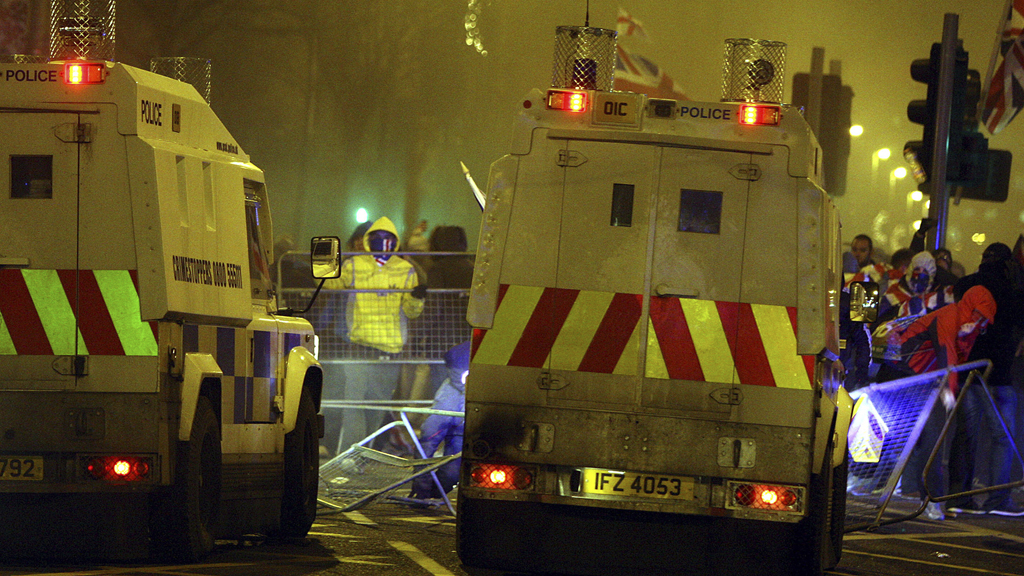Was Belfast flag riot part of a loyalist backlash?
Violent scenes outside Belfast city hall show that sectarian divisions remain strong in the city. As Sinn Fein gain more ground, are they provoking a backlash by loyalists?

Violence erupted in Belfast last night as the city council voted to remove the union flag from city hall, the first time the flag has been removed since the building opened in 1906.
A mob of 1,000 angry loyalists laid siege to the building, attacking police as they tried to smash their way into the council chamber. Inside, the Alliance party had blocked nationalist plans to permanently remove the flag, but it will now fly only on designated days.
The disturbances unfolded to the background of continuing dissident republican attacks in Northern Ireland, and a burgeoning nationalist vote.
In July a loyalist flute band was filmed playing the “famine song” outside a Catholic church, heightening tensions ahead of the Ulster covenant march in September that saw an estimated 30,000 rally on the streets of Belfast.
Shredded nerves
Gareth Mulvenna, a Queen’s University Belfast research fellow who specialises in the Protestant working class community, believes frictions over the flying of the union flag are a throwback to the Anglo-Irish agreement controversy of the mid-1980s.
“On the one hand unionist and loyalist confidence in the British government has never been revived since 1985, while on the other the constant shots across the bow from a highly confident Sinn Fein have shredded the nerves of those who turned up to protest about the flag being removed.
“The passion demonstrated by the protesters before things turned nasty illustrates how important the union flag, and the symbolism of Belfast city hall as a link with the rest of the United Kingdom, is to swathes of unionists and loyalists in Northern Ireland.”
“Sinn Fein’s desire to see the Irish tricolour fly beside the union jack, or have it taken down, is an orchestrated tactic on the part of the republican party which, while not written into its manifesto, is abundantly clear in its passive-aggressive politicking.
“The message is obvious: destroy unionist and loyalist confidence and the rest will follow.”
Lashing out
Mr Mulvenna explained that the prospect of Scottish independence has impacted heavily on loyalists, who feel isolated and are now lashing out.
“If Alex Salmond gets his way the ‘narrow sea’ could become a vast ocean. Many loyalist communities in Northern Ireland are still trying to come to terms with the legacy of the troubles.”
“The Belfast agreement has simply not delivered the dividends that were promised to the very poorest Protestant constituencies in Northern Ireland.
“In this climate debates over the very essence of the Union have accelerated loyalist angst and the reaction has been predictably combustible.”
Changing demographics
The DUP and UUP distributed 40,000 leaflets in the weeks before the protest condemning the Alliance party, a liberal non-sectarian party that took the DUP’s East Belfast House of Commons seat in the last election.
The leaflet accused Alliance of backing Sinn Fein, in a move that could seriously impact their vote in loyalist east Belfast. The party strongly denied forming a pact with naionalists and is proposing flying the flag from the cenotaph at city hall as a “reasonable compromise”.
Alliance holds the balance of power on the council and has confirmed it is likely to back the proposal when it comes before a committee meeting in the new year.
A slow demographic change, coupled with increasing confidence, has seen a growth in nationalist voters in Northern Ireland. The prospect of a Catholic majority communiy is also a serious issue for political parties to address.
Of Belfast’s 51 city councillors, Sinn Fein has the most with 16. Unionists lost control of the council in 1997, but it was not until 2011 that nationalists outnumbered them.
New figures released this year showed that there are more Catholics in nursery, primary, second and third level education.
Shadow of sectarianism
John Lowry has been involved in politics in Belfast for 25 years as a member of the left-wing Workers Party, and believes not enough has been done to bridge the gap between the two communities.
“It’s a case of living together separately. The DUP and Sinn Fein have carved up the situation but there are no real moves towards integration,” he told Channel 4 News.
“Sectarianism is still alive in Northern Ireland, despite the Stormont executive’s efforts, and the number of peace walls are actually increasing.”
Mr Lowry warned that while there is no excuse for the violent scenes that erupted outside city hall, there were important social problems in Belfast that were failing to be addressed.
“The feeling with ordinary people here is: why was it necessary to discuss flags at all when there are far more pressing issues affecting people’s lives like housing and rising prices?”
“The pitiful sight of thousands of people protesting outside Belfast city hall about flags is matched only by a chamber full of councillors debating it inside.
“The real questions that must be asked about this tribal debacle are the ones that Sinn Fein and DUP voters in particular must ask of themselves.”
-
Latest news
-
Laughing Boy: New play tells the tragic tale of Connor Sparrowhawk5m

-
Sewage warning system allows some of worst test results to be left off rating system, analysis shows3m

-
Post Office inquiry: Former CEO didn’t like word “bugs” to refer to faulty IT system4m

-
Israeli soldier speaks out on war in Gaza12m

-
PM’s defence spending boost should be ‘celebrated’, says former Armed Forces Minister4m

-




